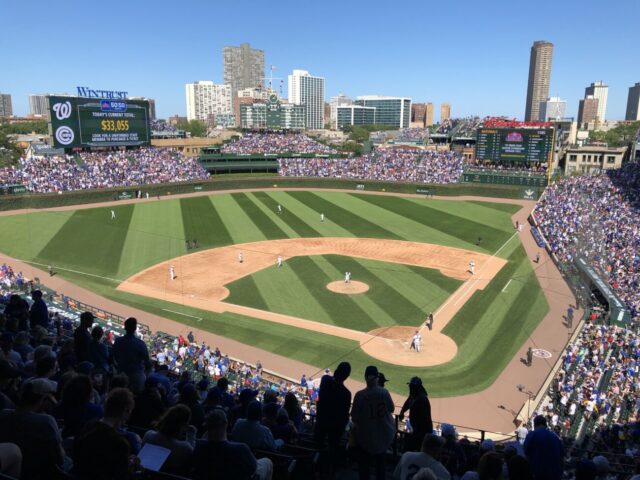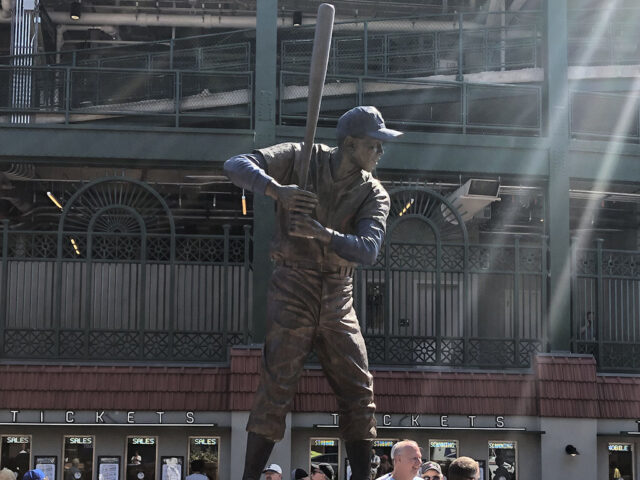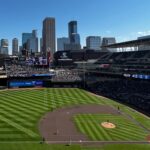If you’re a baseball fan with an appreciation of history, it’s quite likely that Wrigley Field is at or near the top of your list of stadiums to visit.
Heck, even if you’re not a baseball fan, it’s quite likely that Wrigley Field is at or near the top of your list. It’s located in one of the country’s most vibrant cities, it serves as the home of one of American sports’ most popular teams and it offers one of the most gorgeous settings in baseball.
And then there’s the history, as Wrigley Field is one of the most historic venues in all of sports. Let’s dive into the ballpark’s incredible history and why it makes the Chicago Cubs’ home such a popular place to visit.
Why is Wrigley Field important?
The U.S. Secretary of the Interior deemed Wrigley Field a National Historic Landmark in 2020. But why did they do this? Officially, it was because Wrigley Field played a significant role in the history of Chicago and professional sports.
Many important baseball events and innovations took place within Wrigley Field (more on that below). Plus, it’s the oldest-standing National League park. In addition, it’s the only remaining ballpark connected to the now-extinct Federal League.
So yeah, the Secretary of the Interior had it right.
What is Wrigley Field’s nickname?
Wrigley Field has taken on the nickname “The Friendly Confines.”
It got this nickname after a phrase popularized by former Cubs first baseman and Hall of Famer Ernie Banks.
Where is Wrigley Field?
Wrigley Field is located on the north side of Chicago. Specifically, it’s located at the intersection of Addison and Clark streets, where you can see the famous red marquee on the side of the park.
The neighborhood in which Wrigley Field is located has become known as Wrigleyville, which is largely residential (including the buildings across the street that house the famous Rooftop Bleachers). It is full of restaurants, entertainment and hotel options – most of which cater to baseball fans but remain open throughout the year.
Wrigley Field is which team’s home?
Wrigley Field is the home field of the Chicago Cubs.
Chicago’s NFL team, the Bears, once played at Wrigley Field. Workers painted the gridiron over a part of the field and placed bleachers over half of the field.
The Bears played at Wrigley Field until 1970, when they moved to their current home, Soldier Field.
How big is Wrigley Field?
Despite its popularity, Wrigley Field is one of the smallest stadiums in MLB. It has a seating capacity of only 41,649.
Wrigley Field’s famous ivy-covered walls front the outfield bleachers, which are one of the most famous spots in the majors to watch baseball. The walls have baskets at the top to prevent fan interference.
Good things can come in small packages. This small stadium nestled into a residential neighborhood is still full of charm.
When and why was Wrigley Field built?
Charles Weeghman, the owner of 15 lunchrooms in Chicago, decided to take over the “Chifeds” baseball team for the 1914 season. But where could his team play? His solution was to build a brand new baseball park of his own.
He chose a vacant lot on the north side of Chicago. Then he hired local architect Zachary Taylor Davis to design the ballpark. The groundbreaking ceremony took place on March 4, 1914 and the park opened on April 23, 1914.
Wrigley Field was not called Wrigley Field when it first opened. The name Weeghman Field came from the field’s creator. It received the name Wrigley Field in the late 1920s from the Cubs’ owner at the time, chewing gum magnate William J. Wrigley.
Events that happened at Wrigley Field
So which important baseball events have happened at Wrigley Field in its long history? Here’s just a partial list:
- The double no-hitter between the Cubs’ Hippo Vaughn and the Reds’ Fred Toney in 1917
- The famous Babe Ruth “called shot” in the 1932 World Series
- The “Homer in the Gloamin'” shot by Cubs catcher Gabby Hartnett in 1938
- Cubs legend Ernie Banks’ 500th home run in 1970
- Pete Rose’s 4,191st hit, tying Ty Cobb’s all-time record, in 1985
- Kerry Wood’s 20-strikeout game in 1998
- Sammy Sosa’s 60th home run during the 1998 home run duel with Mark McGwire
- Hall of Fame left-hander Tom Glavine’s 300th career win in 2007
- The Cubs’ pennant-clinching win in 2016 (on their way to their first championship since 1908)
- The MLB All-Star game in 1947, 1962 and 1990
Additions to Wrigley Field
Many of the features that Wrigley Field is now famous for didn’t exist when Weeghman originally built the park. They came in over the years. Below you’ll find a list of some significant additions that took place at Wrigley Field:
- The hand-operated scoreboard in center field was built in 1937
- The outfield bleachers were also introduced in 1937
- Bill Veeck planted the famous ivy in 1937
- Workers added lights in 1988 (making Wrigley the last MLB ballpark to have them installed)
Multiple renovations have also taken place in the over-a-century-old baseball field. In total, the field has gotten the following:
- New office spaces
- Refurbished old office spaces
- A new ticket office
- A new home clubhouse
- A renovated visitor’s clubhouse
- Several private boxes
- A food court
- Broadcasting booths
- An elevator
- A restaurant
- An indoor batting cage plaza
- The Budweiser Patio
The 1060 Project, the series of renovations that began after the 2014 season, also improved Wrigley Field in several ways. It preserved the original look of the field but still upgraded it. Among the additions were videoboards, expanded concessions, premier clubs, bleacher bar spaces, and an exterior plaza.
What to do at Wrigley Field
So what can you do if you visit Wrigley Field? See a baseball game, obviously, but there’s more to do.
Look at the statues
On the corner of Clark and Addison and around the ballpark’s perimeter, you’ll find a great artistic sight. At that location, you can see statues of Cubs legends Ernie Banks, Billy Williams, Ron Santo and Harry Caray. The franchise added a new statue, of Ryne Sandberg, before the 2023 season. Check them out and maybe take pictures with your favorite one.
Take a tour
Yes, the stadium offers daily tours. They last around 90 minutes and take you behind the scenes with an experienced guide. Keep in mind that tours vary depending on if there’s a game occurring.
Get a First Game Certificate
This cute piece of memorabilia is mostly meant for younger fans, but older fans can enjoy it too. Visit the Fan Services Booth before the first pitch to get one.





 Edward de la Fuente | Itinerant Fan
Edward de la Fuente | Itinerant Fan
